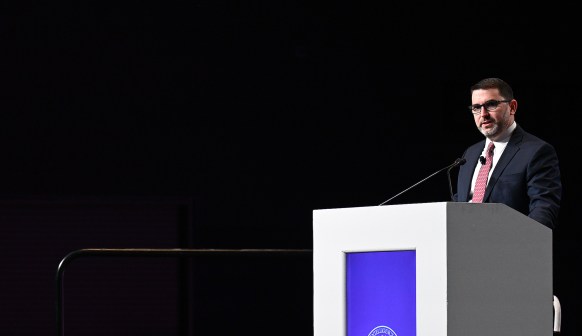
Defense Intelligence Agency Director Lt. Gen. Vincent R. Stewart, a Marine, spoke at the Intelligence and National Security Alliance Leadership Dinner July 30. (INSA)
Hashtag intelligence?
The first Marine to lead the Defense Intelligence Agency, Lt. Gen. Vincent R. Stewart, made quite a memorable first appearance at the recent Intelligence and National Security Alliance Leadership Dinner. The outspoken general (I expect nothing less of my beloved Corps’ generals) may have introduced the world to the concept of hashtag intelligence when describing how the U.S. intelligence community is exploiting social media.
According to Stewart, Twitter provided the first indication in early June that Houthi rebels had fired a Scud missile from Yemen into Saudi Arabia. “The first warning of that event: #scudlaunch,” Stewart said. “Someone tweeted that a Scud had been launched, and that’s how we started to search for this activity. This is the environment the intelligence community now faces.”
Twitter and Facebook may be enabling new methods of intelligence tipping and queuing, but beyond the monitoring of #scudlaunch, the new DIA director was less forthcoming about the agency’s plans to use social media. “Yeah, there are some opportunities,” Stewart said. “I’ll stop there. Because even though it’s open source and publicly available, I think we might not want to talk too much about some of the ways how we’re exploiting that. Not that any of you all would tell our secrets, but …”
Inside Scoop doesn’t like to be paranoid, but something says that was a smart call.
DIA compromised?
Everybody loves a good spy story — not the Edward Snowden steal-your-secrets-and-run-away-scared-type of spy story, but the deep-penetration-agent type. A mole like Aldrich Ames or Robert Philip Hanssen.
The DIA’s new director also apparently likes a good spy story. In fact, Stewart has his counterintelligence agents actively looking for spies — the electronic and people type — inside of DIA.
“When I took over at [Marine Corps Forces Cyberspace], I made this assumption that our networks were penetrated, that our adversaries had penetrated all of our networks, and if that’s the case we ought to go figure out how we find them, and drive them out of our networks, defeat them in our networks,” Stewart said. “I’ve taken that same assumption going into DIA. That if we’re an organization that’s worth a damn that our adversaries are probably interested in what we’re doing and so we’re probably penetrated. So I’ve asked my Office of Counterintelligence to take a good, hard look at everybody in the enterprise, and they’ve actually put some interesting techniques out there and have surfaced some things that concern us. So we’re investing in counterintelligence because if you’re a first-rate intelligence organization, your adversaries are probably trying to get inside. And so, we’re going to go find them and see if we can drive them out of our enterprise.”

“I’ll tell you one area we’ve got to get much better at that the industry can help us with — modeling and simulation,” said DIA Director Lt. Gen. Vincent R. Stewart, speaking at the INSA Leadership Dinner July 30. (INSA)
Industry: I have a job for you
Can you model and simulate content? If so, you might want to pitch your wares to the DIA.
“I’ll tell you one area we’ve got to get much better at that the industry can help us with — modeling and simulation,” Stewart said. “Not just modeling and simulation for advanced weapons systems, but modeling and simulation in a way that delivers content, dynamically and interactively, to our users, where a user can look at different variables and think about the decisions as they see it. The days when we can produce hardcopy — bind it, send it — I mean, it’s obsolete by the time we deliver it to the user,” he said. “So I need a significant amount of help in doing modeling and [simulation], not just for the S&T world, not just for the acquisition world, but how we might deliver content in the future. If anybody’s got any help on that one, we’d like to talk.”
What Stewart actually meant to say is email your ideas to DIA’s Needipedia at Ideas2Action@dodiis.mil.
Send me some Hashtag intelligence on Twitter @DanielVerton






